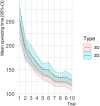Must Clinics Replace 2D by 3D Environments for an Efficient Training of Laparoscopic Novices? A Critical Analysis of the Learning Curve for Basic Skills
- PMID: 35111805
- PMCID: PMC8801449
- DOI: 10.3389/fsurg.2021.792107
Must Clinics Replace 2D by 3D Environments for an Efficient Training of Laparoscopic Novices? A Critical Analysis of the Learning Curve for Basic Skills
Abstract
Background and aims: Published studies repeatedly demonstrate an advantage of three-dimensional (3D) laparoscopic surgery over two-dimensional (2D) systems but with quite heterogeneous results. This raises the question whether clinics must replace 2D technologies to ensure effective training of future surgeons.
Methods: We recruited 45 students with no experience in laparoscopic surgery and comparable characteristics in terms of vision and frequency of video game usage. The students were randomly allocated to 3D (n = 23) or 2D (n = 22) groups and performed 10 runs of a laparoscopic "peg transfer" task in the Luebeck Toolbox. A repeated-measures ANOVA for operation times and a generalized linear mixed model for error rates were calculated. The main effects of laparoscopic condition and run, as well as the interaction term between the two, were examined.
Results: No statistically significant differences in operation times and error rates were observed between 2D and 3D groups (p = 0.10 and p = 0.72, respectively). The learning curve showed a significant reduction in operation time and error rates (both p's < 0.001). No significant interactions between group and run were detected (operation time: p = 0.342, error rates: p = 0.83). With respect to both endpoints studied, the learning curves reached their plateau at the 7th run.
Conclusion: The result of our study with laparoscopic novices revealed no significant difference between 2D and 3D technology with respect to performance time and the error rate in a simple standardized test. In the future, surgeons may thus still be trained in both techniques.
Keywords: 2D laparoscopy; 3D laparoscopy; learning curve; novice; surgical skill.
Copyright © 2022 Sahm, Danzer, Grimm, Herrmann and Mantke.
Conflict of interest statement
The authors declare that the research was conducted in the absence of any commercial or financial relationships that could be construed as a potential conflict of interest.
Figures




References
LinkOut - more resources
Full Text Sources

